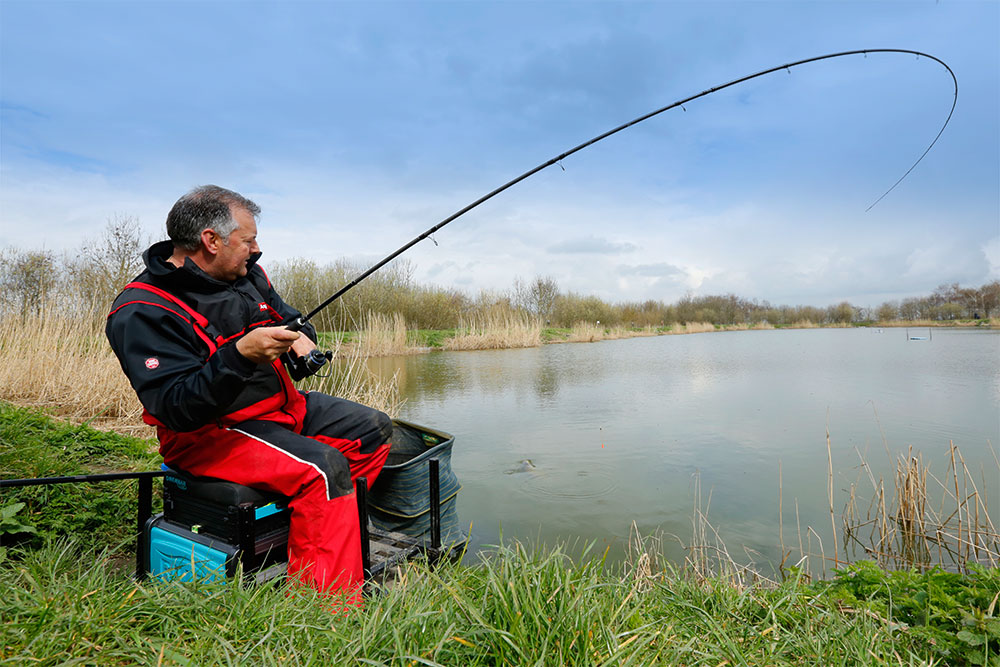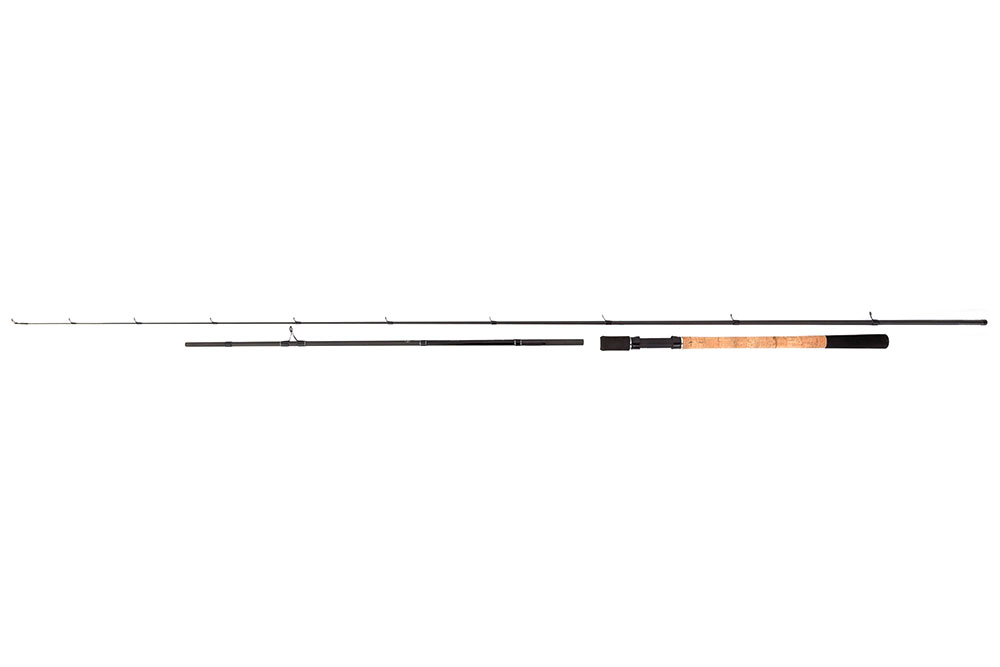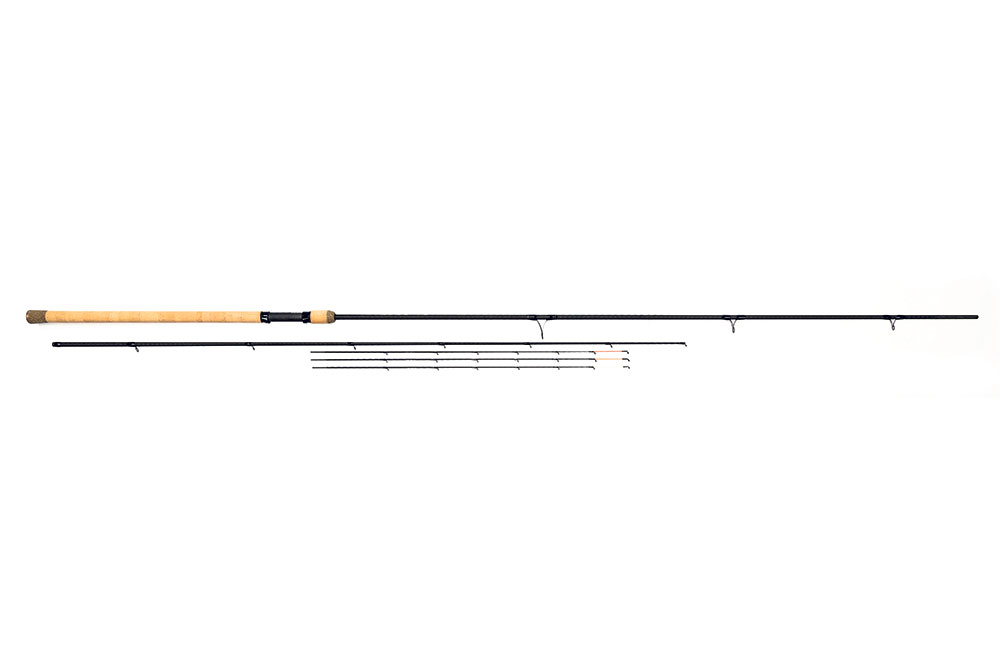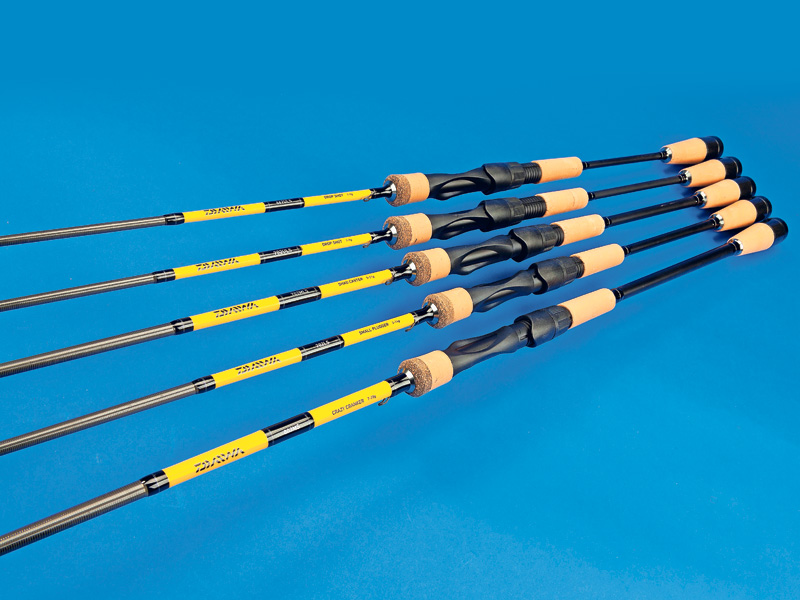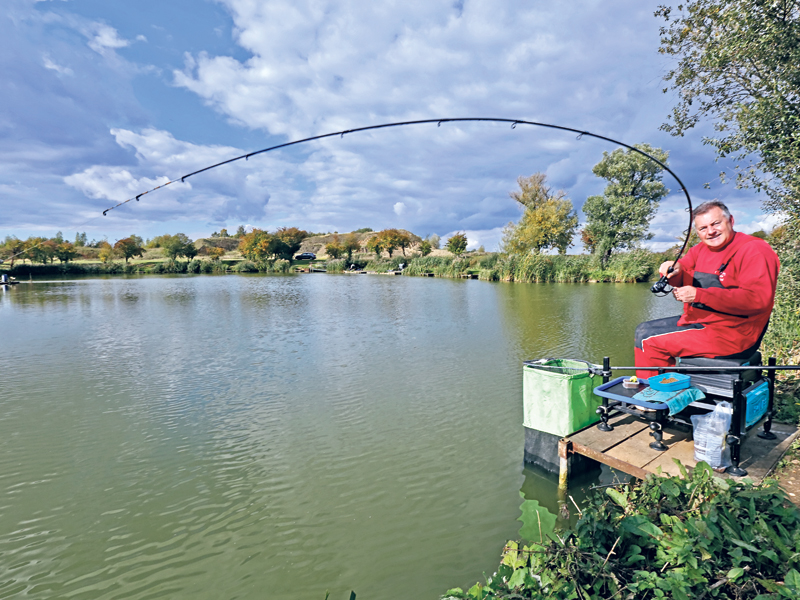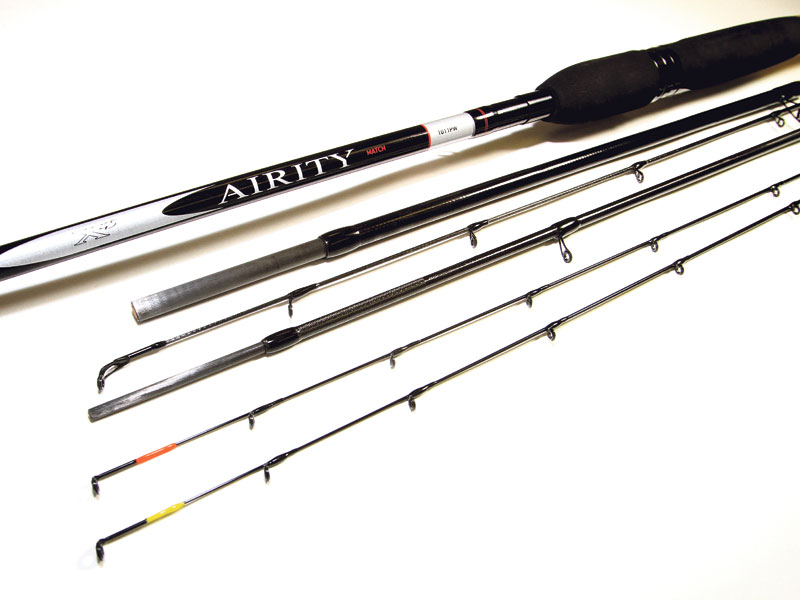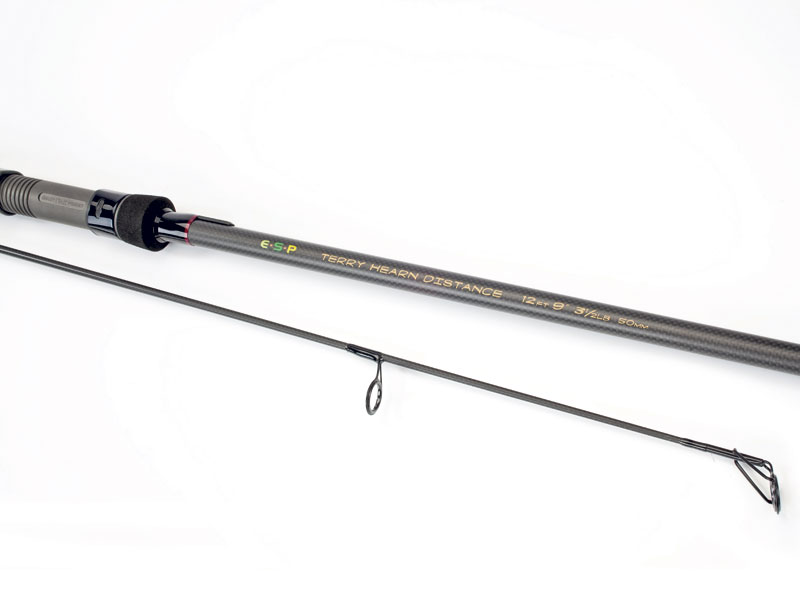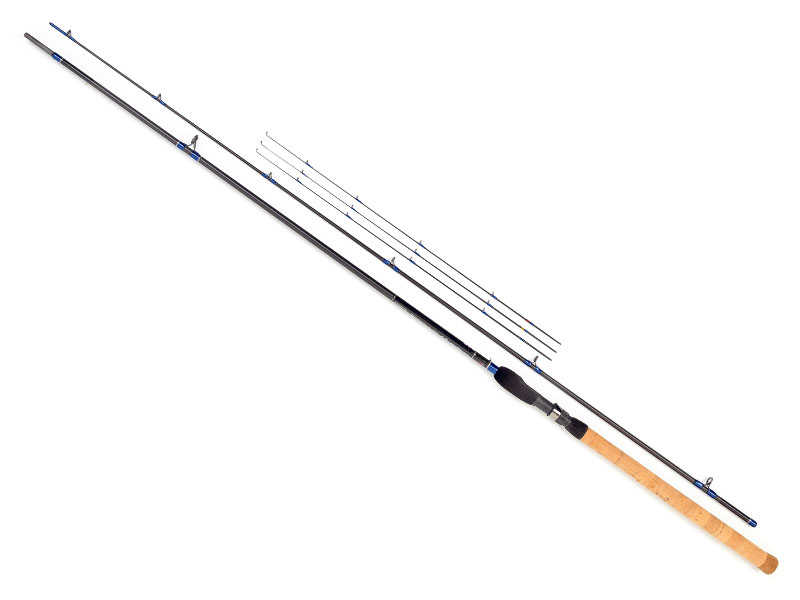Avid Traction carp rods
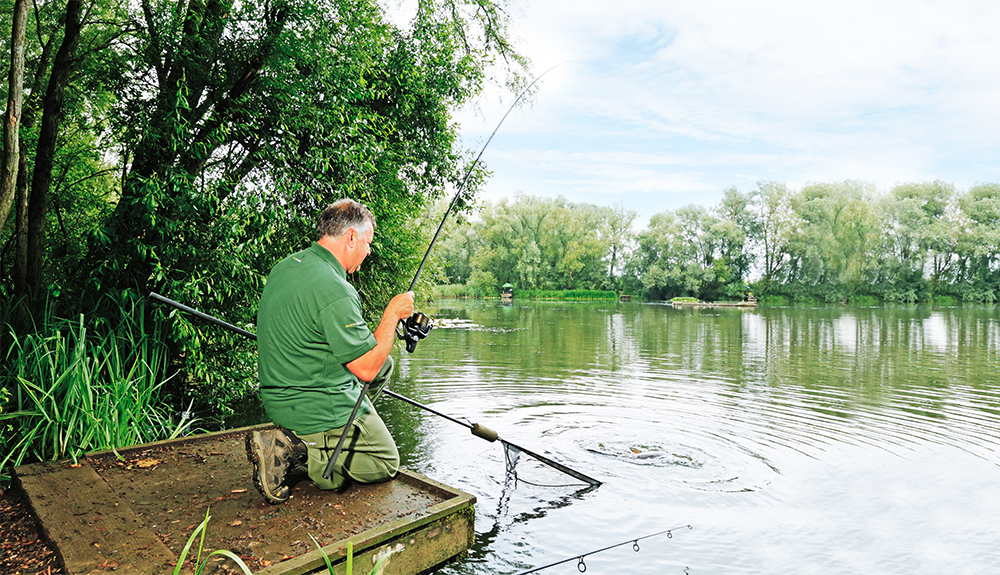
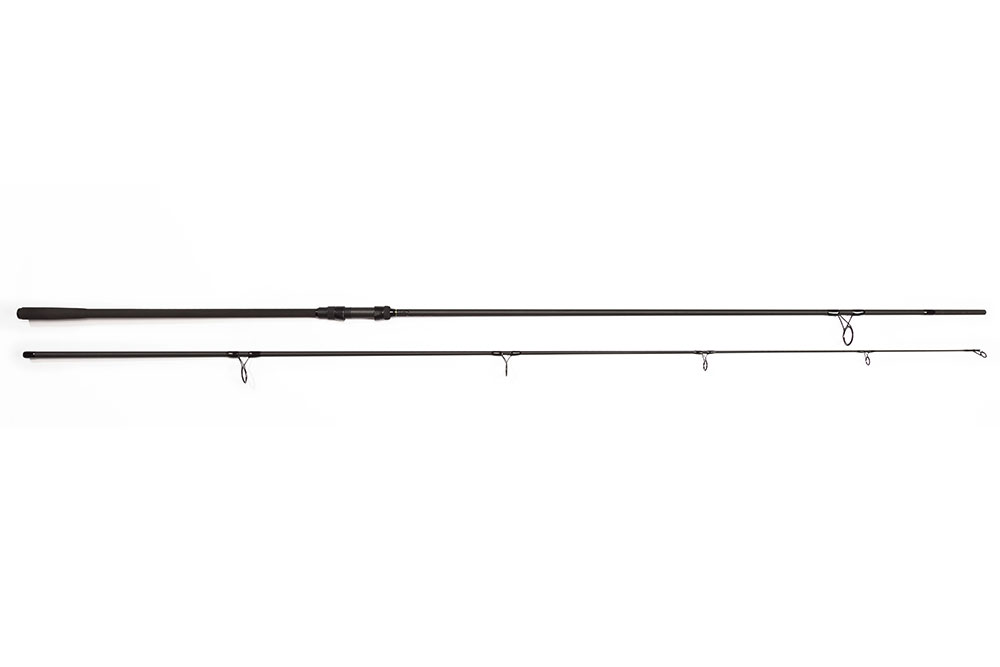
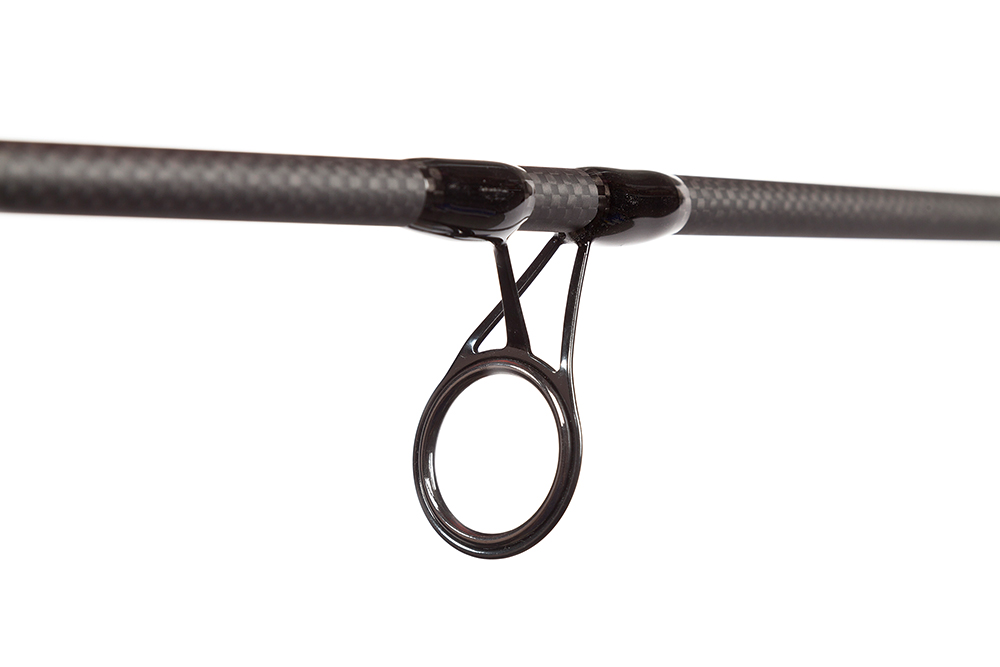
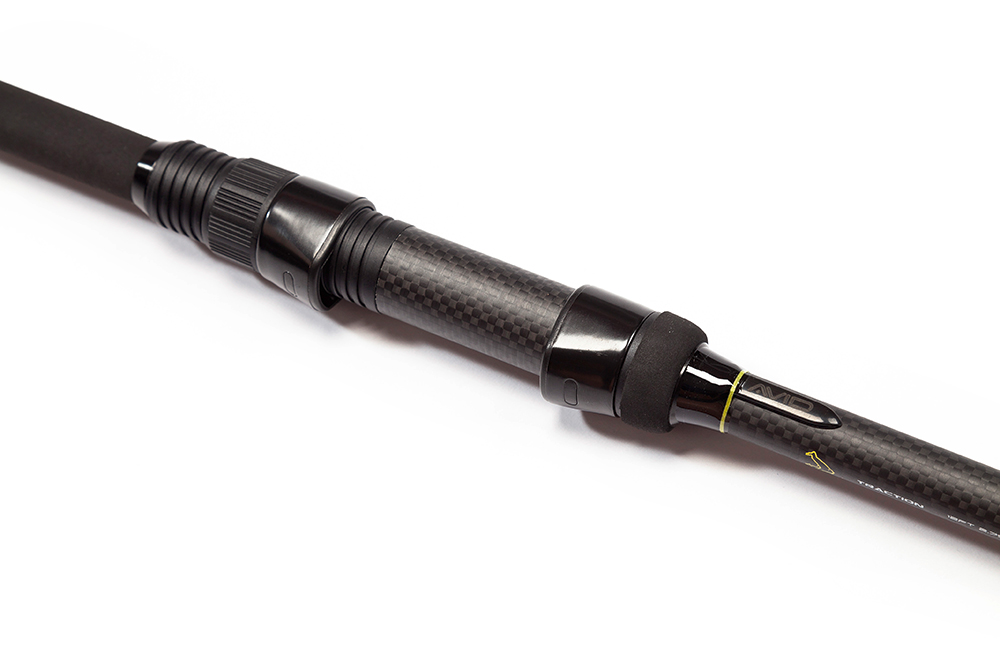
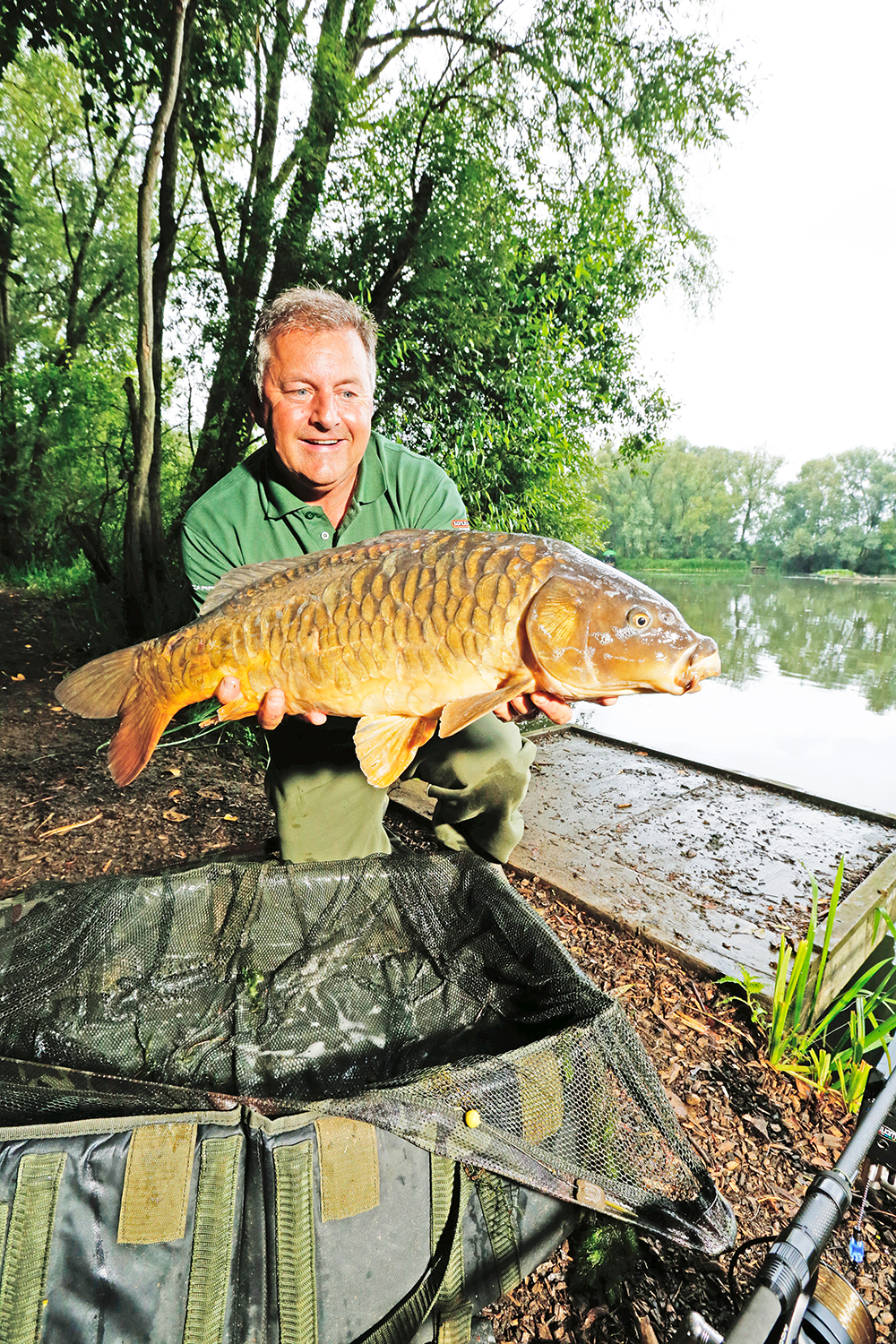
PAY AROUND
£79.99
Since their introduction a little over nine months ago, Avid’s Traction Carp rods have become the benchmark by which all sub-£100 models are judged.
Built from Reactive carbon fibre wrapped in a matt-finished 3K weave, each 12ft blank offers a unique take on the traditional parabolic action beloved of carpers. A slow build-up of power cushions the runs and lunges of hard-fighting fish, offering greater control when it really matters.
It’s just the sort of action needed for a modern day big-carp rod that multi-tasks.
The original Traction models carried test curves of 3lb, 3.25lb and 3.5lb, covering everything from solid PVA bag and stick work to middle to long-range Method feeder and straight lead work.
I more than proved the point when live testing a pair of the 3lb models last November at a cold and rather uninviting-looking Boddington Reservoir where a whack of 90-plus yards with a 3oz pellet-laden Method feeder was needed to reach its denizens.
You might think that most of the general heavy-duty casting work would be taken care of by the 3lb, 3.25lb and 3.5lb models. Avid’s development team could indeed have been forgiven for lying back on their super-comfy Benchmark bedchairs and feeling a bit smug.
But not a bit of it – enter the new 2.25lb and 2.75lb test curve blanks. Both rods boast the same Reactive carbon and 3K weave as the originals, but they have a slightly softer parabolic action suiting them to smaller waters, more modest casting distances and surface and zig rig tactics.
To test these attributes, what was needed was a medium-sized lake with a healthy stock of big, snippy fish that could be tempted on a wide range of tactics.
Northamptonshire’s day-ticket Willowbrook Lake, jam-packed with handsome fish to almost 30lb, fits the bill. It’s a superb daylight venue, especially if you’re after wetting the unhooking mat without waiting all day for a run.
First up was the new Traction 2.75lb rod, rigged with a 1.5oz inline Avid lead and solid PVA bag full of micro pellets.
The blank took little persuasion to launch its payload to the centre of the lake, close to a man-made floating island. It could easily have been burdened with a heavier lead and tasked with a far longer cast.
The slightly softer 2.25lb model was kitted out with a zig rig and 2oz lead, cast close to one of the numerous lily beds. It handled the weight easily enough, but it’s definitely not a rod with lots of clout. For all zig, surface and margin work, though, it’s ideal.
I didn’t have to wait long for the alarm to sound, as what felt like a decent fish ploughed straight through two weedbeds before I even had a chance to pick up the rod and tighten down the clutch.
Summer carp in shallow water can be tricky enough to cope with on their own, without having half a hundredweight of weed festooned along the line like so much washing. With the 2.75lb blank, it seemed all would be lost.
But deep in the belly of the blank was a core of steely strength with enough pulling power to drag the beast from its lair. The fish, having gone underneath the weed and out the other side, was still snarky about being hooked, but eventually both carp and weed came safely over the net cord.
What more can you say, other than that these rods are fabulous? I also managed two on zig rigs on the lighter model, and would happily add both to my holdall.
VERDICT
Two more sure-fire winners from the Avid stable. The addition of lighter 2.25lb and 2.75lb test curve rods further enhances the comprehensive Traction Carp range. Ideal for smaller waters, but still more than capable of handling very big fish, the heavier rod is perfect for small bags, Method feeders and zigs.
Its lighter compatriot would make an awesome shallow water zig, surface and margin tool.
Browning Commercial King2 Medium Pellet Waggler rod
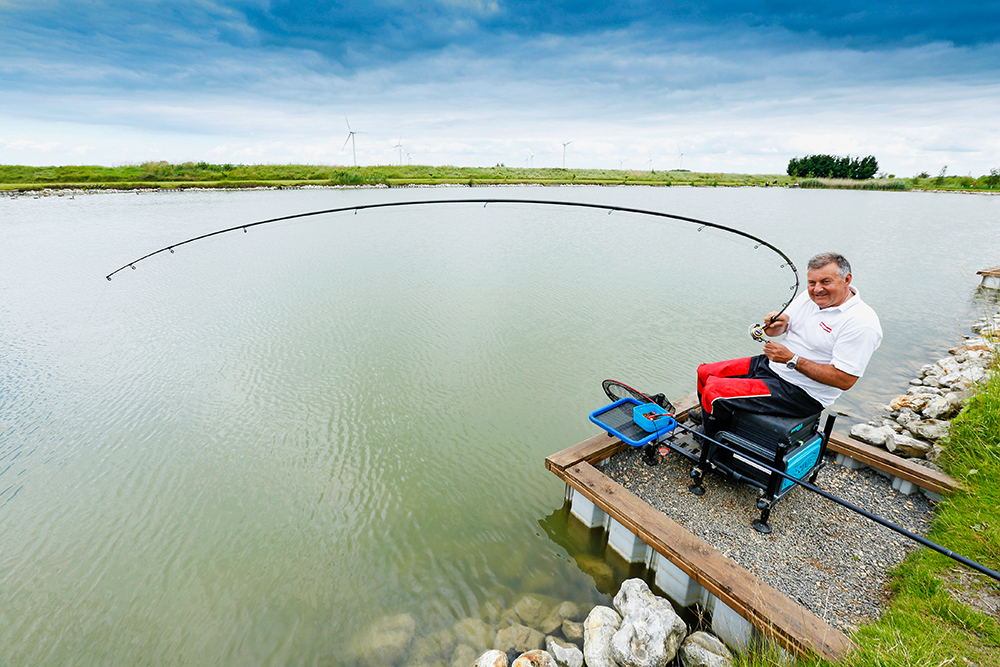
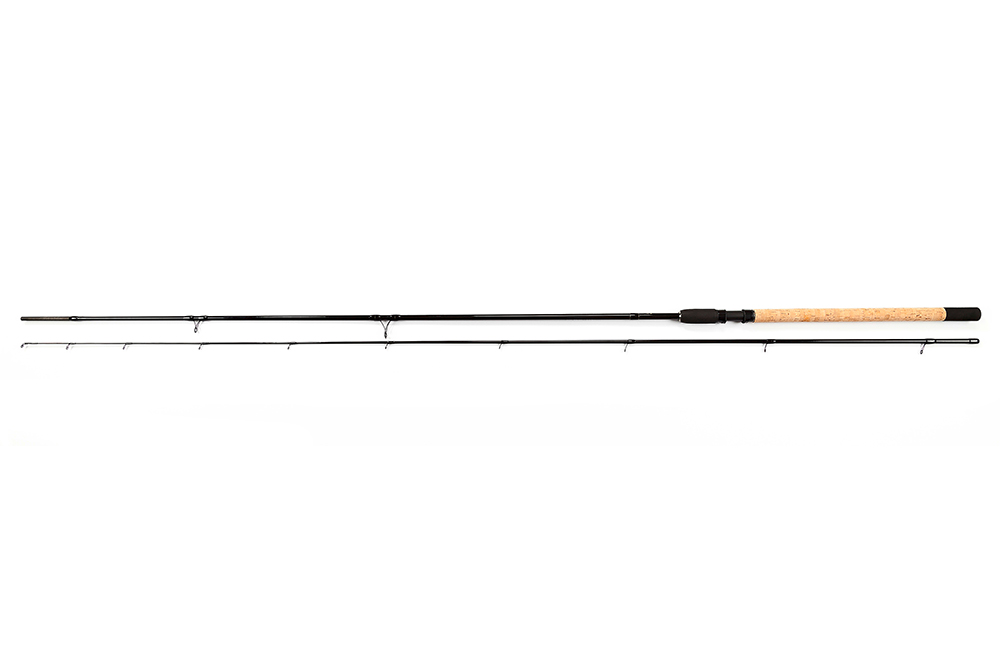
QUICK FIX
Top section: The top section of the rod has
a quick tip action with a fast recovery rate. This allows you to make longer and smoother casts.
Fittings: High-quality line guides are used throughout, producing super-slick casts no matter how great the diameter of your line.
Blanks: Made from ultra-slim high-modulus carbon blanks, they have two equal lengths so that they are ideal for carrying ready made up.
Action: The rods have a perfect parabolic non-locking action which is ideally suited to commercial fishery carp of any size.
Handle: The new Commercial King2 rods
are designed with shorter cork handles so that they can be more easily manoeuvred around the angler’s body.
PAY AROUND
£69.95
Browning has revamped its range of Commercial King rods.
The latest models retain many of the build characteristics of the originals – slim carbon blanks, two equal-length sections and a responsive, progressive action.
However, Browning has further refined its best-selling UK range with improved cosmetics, beefed-up casting prowess and a tweak to provide a little more power through the mid-sections.
All this has been accomplished without Browning significantly hiking up its prices, which something to be applauded.
So, with the summer sun in full water-warming mode and carp cruising about all over the surface of nearly every lake I have visited in the past two weeks, it made perfect sense to take a closer look at Browning’s latest Commercial King2 Pellet Waggler rods.
These 11-footers come in Medium and Power versions, the latter boasting around 15 per cent more stiffness and power for situations involving bigger fish, or casting heavier floats up to 30g.
My chosen test venue, The Pool at Fields End Fishery in Cambridgeshire, is noted for its mixed stocks, so I chose the Medium model with a maximum casting weight of 20g. This is ideally suited to lighter floats, hooks and lines.
Assembling the rod, it’s immediately apparent that this is quality kit. At only 175g, it’s nicely balanced, with a super-quick tip action and fast recovery. That means it doesn’t wobble around much, making long, smooth casts easy to achieve.
My float choice was the small flighted John Bonney model that comes free on the front of Angling Times this week. It flew across the Pool to a range of 25m with no effort. The slightly reduced handle length made feeding with a catapult equally effortless, and that made very short shrift of what can otherwise be a rather tiresome ‘feed and cast’ routine.
Feeding little more than half-a-dozen 6mm pellets every 20 seconds or so, it wasn’t long before dark shapes were coming in to feed as soon as the pellets hit the water. But, as often happens on a well-fished venue, as soon as the float splashed down, they high-tailed it out of the swim.
The answer to this fishy conundrum is to feed twice, immediately before and after casting. You will also need to feather the line, so that the float lands with a gentle kiss on the surface. Get it right, bites will be savage. You now need to get them out of the killing zone as quickly and quietly as possible, by keeping the rod low, simultaneously reeling and pulling back.
For this you need full confidence in your rod, and reel for that matter, keeping the fish moving without pulling the hook, breaking the line or having the fish charge back through the feeding shoal. Basically you are pushing your kit to it limits, and it needs to respond and perform in equal measure.
This latest Commercial King2 Medium Pellet Waggler rod does exactly that. The added bit of muscle Browning has added kicks in as the blank approaches full parabolic compression, but its non-locking action provides enough of a safety factor for you to be able to dish it out without fearing the worst.
I was also impressed with the rod’s ability to deal with fish other than carp. During the live test some pretty hefty ide decided to have a go. These are not exactly cage fighters, but can be welcome weight builders in matches.
Their lolloping ‘fall-over’ swimming action means they are effectively dragged towards the net – hook-pulls happen all too often when using carp-style pellet waggler tactics. But not with this rod. It handled everything from near-double-figure carp, through to heavyweight ide and big roach, with aristocratic disdain.
VERDICT
I really liked the original Browning Commercial King rods, rating them right up there with many of the best models then available.
These latest rods look, feel and perform with every bit as much style, but with a little more bite.
Improvements to the cosmetics and furnishings give them an expensive top-end look which belies their very sensible price tags.
Mark Sawyer
JW Young Specimen Barbel Multi Tip Travel rod
PAY AROUND
£99.99
This is a handy little travel rod for anyone thinking about sneaking in a spot of barbel fishing when they’re on holiday. Ideal to tuck away in the boot of the car, the five-sectioned 12ft carbon blank has a powerful through action, able to deal with the largest of fish.
It comes with push-in quivertips of 2.5oz, 2oz and 1.5oz, and an Avon-style tip that could be used for heavy floatfishing. In a tough go-anywhere tube, other key features include high-quality lined guides, keeper ring, and a full cork handle with forefinger grip.
Colmic Scrape Xtreme Next Adventure 35g Feeder rod
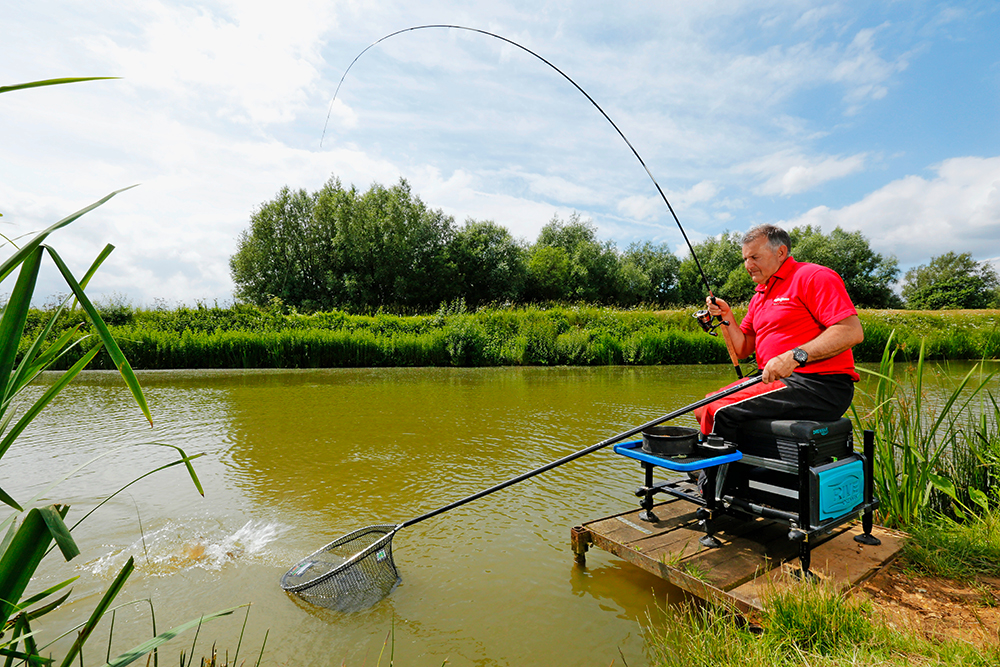
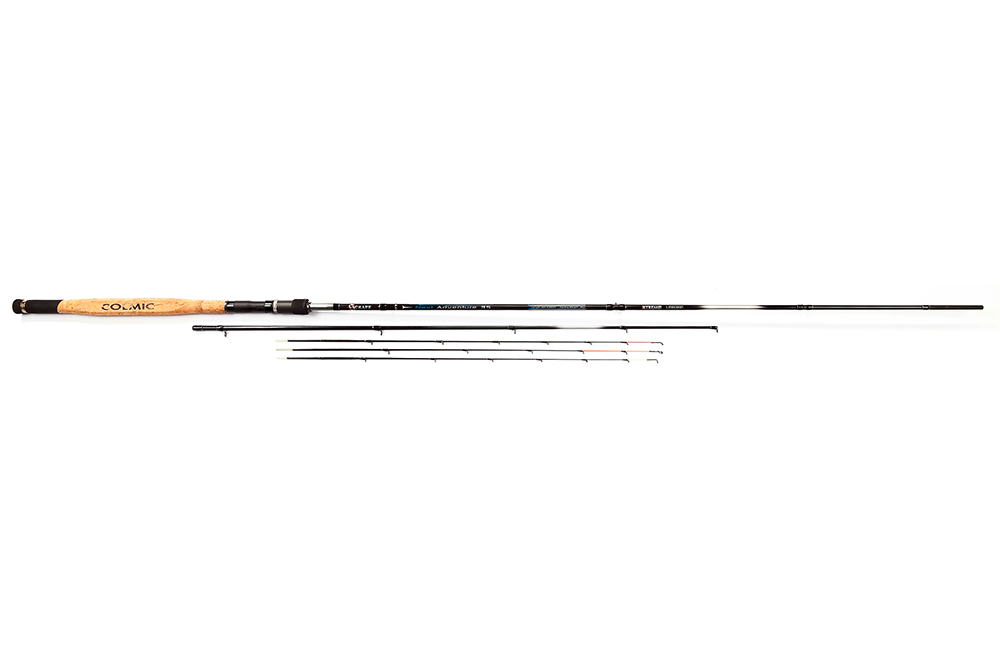
PAY AROUND
£77.99
Italian brand Colmic has been around the UK match scene for many years, with products such as Colmic Jolly pole floats..
Its nickelled Nuclear 501 pattern is the forerunner to many commercial carp hook designs, and it’s fair to say that Colmic poles – and rods, for that matter – have proved very popular.
It’s always going to be tricky for a European company to gain a really strong foothold, though – think Trabucco and Tubertini.
However, at this year’s Big One show Colmic revealed several very impressive new poles, seatboxes and rods for commercial fisheries.
One of the outstanding new rod concepts at the show was Colmic’s three-rod 9ft 25g, 10ft 35g and 11ft 45g Scrape Feeder Xtreme Next Adventure series. All three of the two-piece blanks have a typical fast parabolic action, marrying a forgiving tip section to a mid-section with plenty of backbone, allowing fish to be played quickly to the net without the risk of hook-pulls or snapped lines.
Colmic has built its three Adventure rods with a taper unique to each in respect of casting distance and feeder weight. The shorter the rod, the faster the taper – the longer the rod, the stronger its lever, which translates into casting power and ability to bring fish quickly to the net. All three models are said to be ideal for use with cage, pellet, Method and block-end feeders, as well as straight lead tactics.
The model on live test duty, the mid-range 10ft 35g rod, should be well suited to most short to mid-distance feeder work on a normal commercial fishery.
The proving ground for the theory was Decoy’s fish-packed Lou’s lake, a horseshoe-shaped water that responds particularly well to far-bank feeder tactics. Accurate casts of around 35m are needed to get the best from it.
Starting the session using a lightweight 15g flatbed Method feeder, the sporty Italian blank cast straight as a die time after time, and despite early reservations about its short and rather delicate looking quivertip carrier section, the silver-etched black blank really did produce an impressively fast parabolic action. Carp from 2lb-5lb were beaten in double-quick time.
The rod comes with three push-in fibreglass quivertips of 1/2oz, 1oz and 1.5oz, and the featherweight blank features two double-leg lined guides on its butt section, with another five single-leg lined guides perfectly placed along its carrier section to emphasise the fast taper action.
Suited to mainlines up to 8lb and hooklengths down to around 0.12mm, it’s lots of fun to use, mainly because it’s nigh impossible to lock up.
As an all-round commercial feeder rod it not only looks different from the norm, but it performs in a refreshingly different way from your average bog-standard commercial feeder rod… grazie Colmic!
VERDICT
Don’t let its name or dual colour scheme put you off – Colmic’s Scrape Xtreme Next Adventure 35g Feeder rod is quite something! Perfect for short to medium casting ranges, the blank lands substantially big fish in double-quick time, even on light gear.
If you visit a commercial fishery where the fish’s mouths are a bit messy and prone to hook-pulls, you should definitely have a look at this rod soon.
Preston Innovations Carbonactive Mini 11ft 6ins Method rod
PAY AROUND
£169.99
This super rod from Preston Innovations is designed for medium to long-range feeder fishing.
The two-piece carbon blank has power aplenty to launch a fully loaded Method feeder upwards of 60m.
But it’s not all brawn – the blank still has enough softness to absorb powerful lunges from big fish, doing away with hook-pulls at the net.
The rod comes with two fast-taper quivertips that give instant bite registration, and super-positive line pick-up speed even at extreme distances.
Tri-Cast Trilogy Commercial Pond Wand

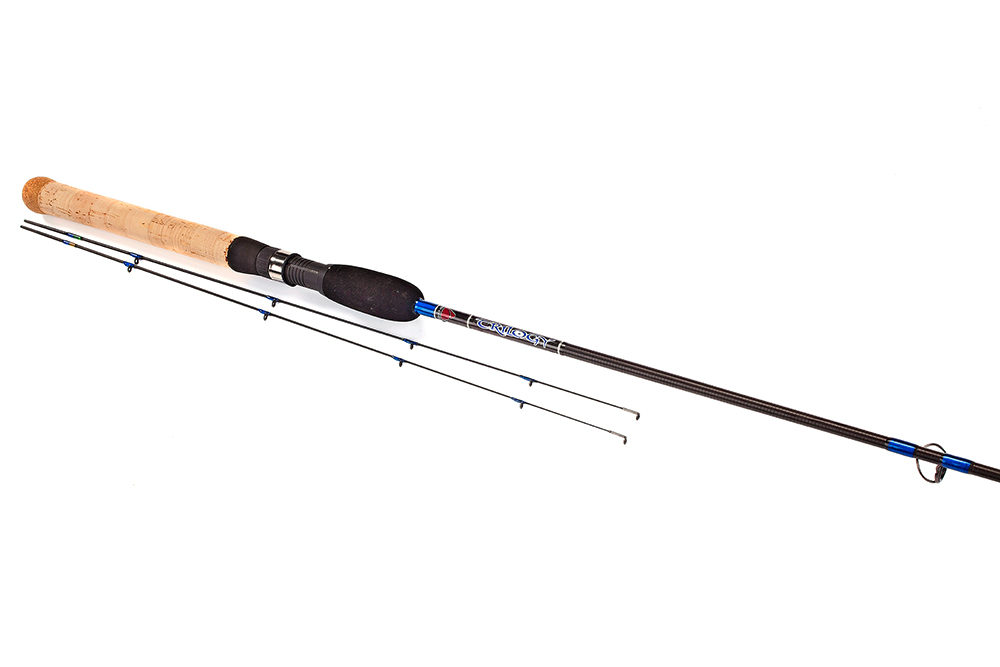
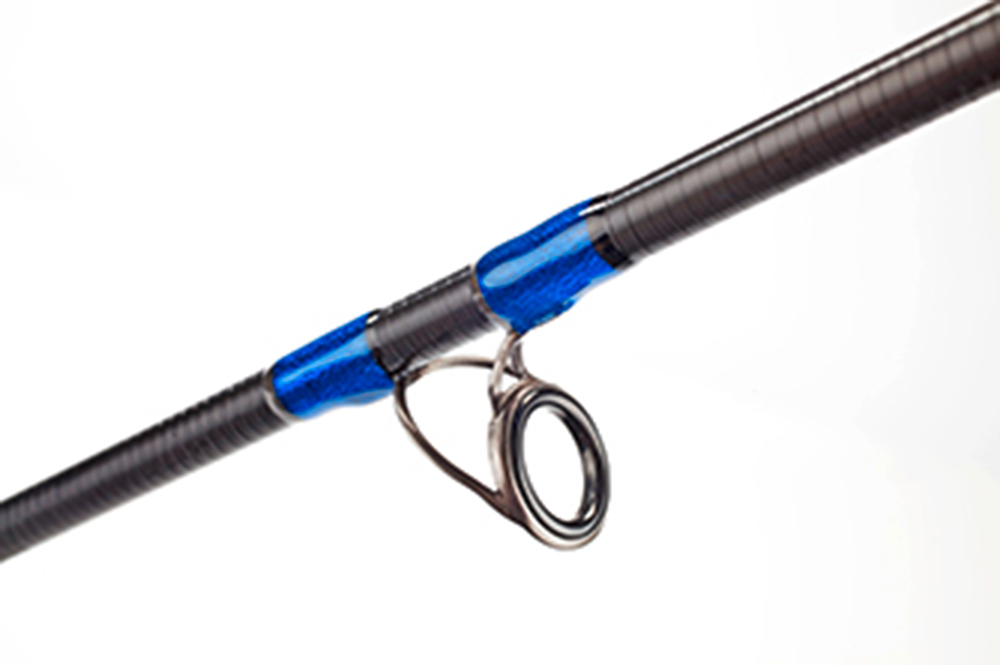
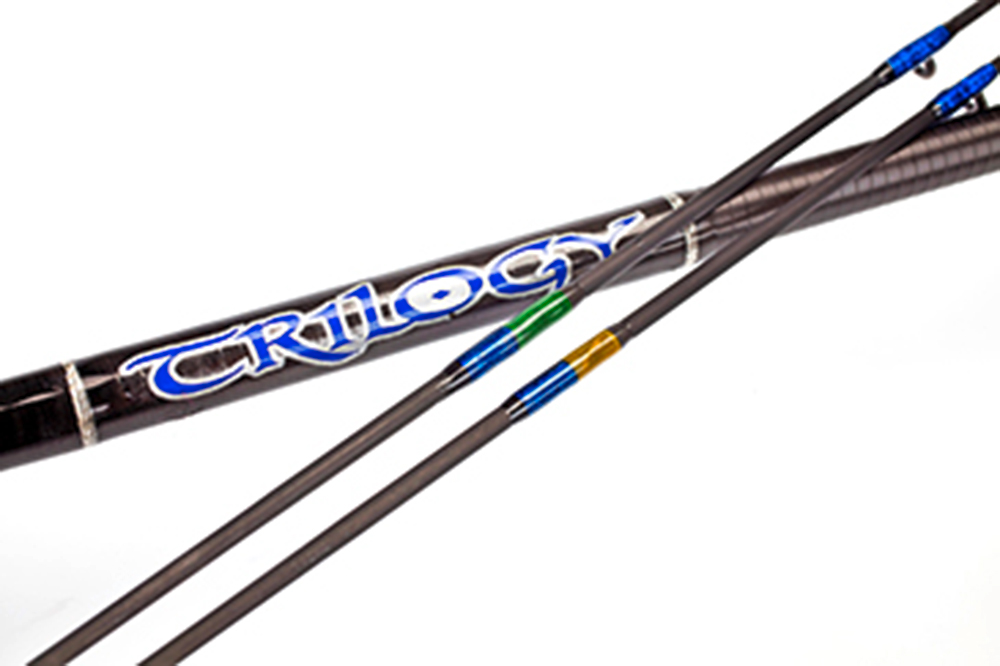
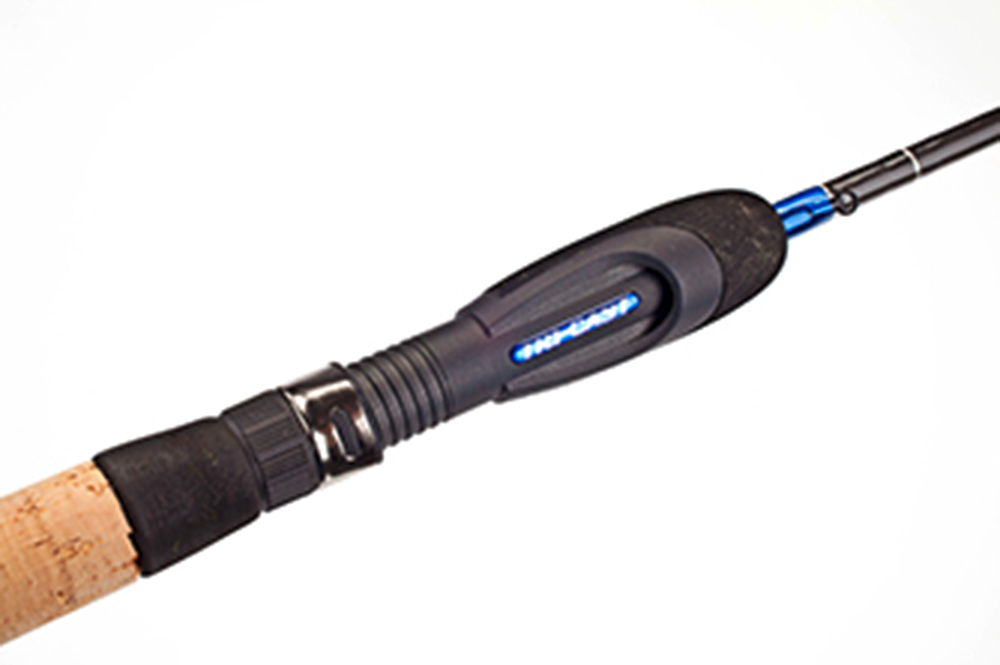
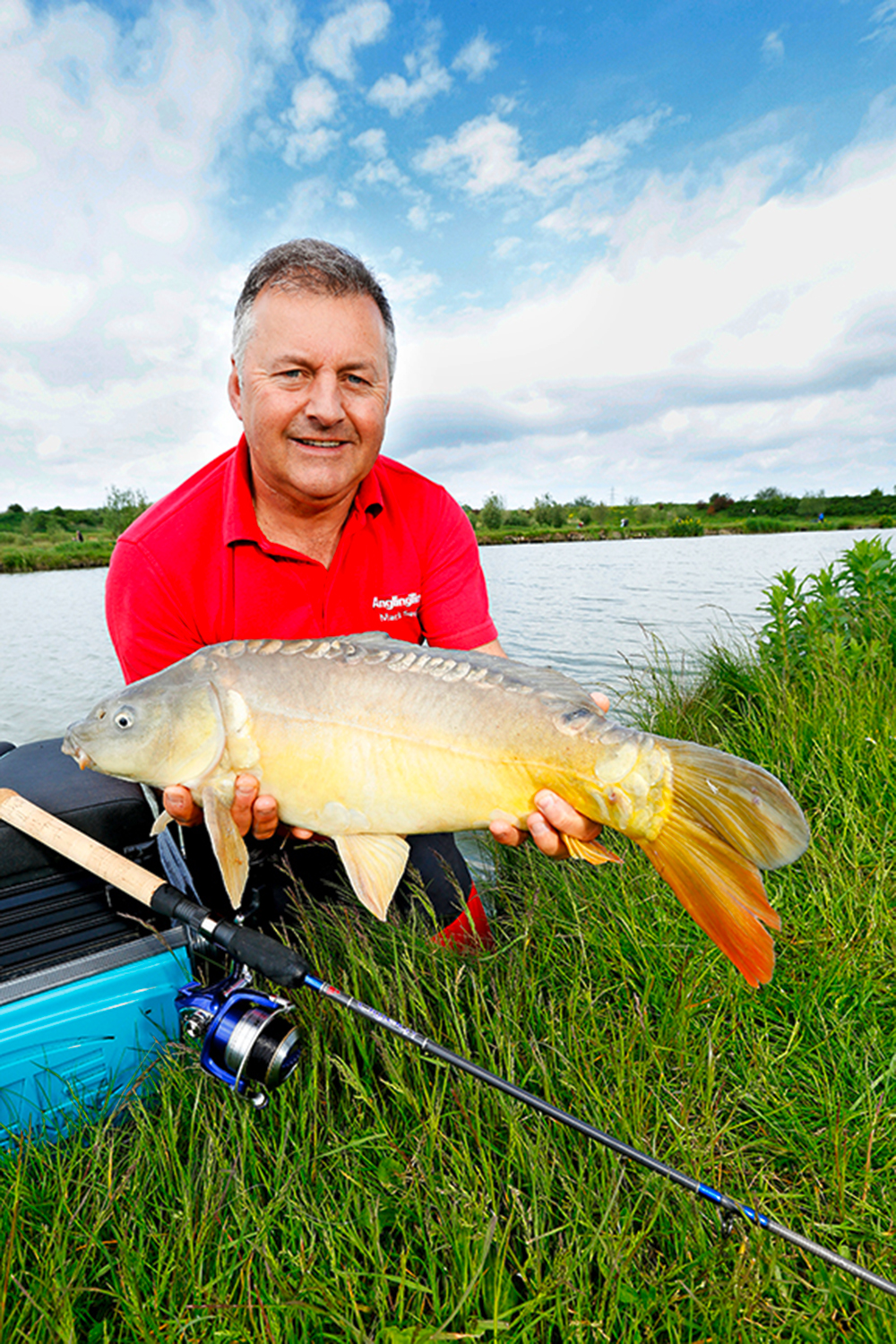
PAY AROUND
£109
I must confess that as I slid this single-sectioned rod from its transit tube my first thought was: ‘What am I supposed to do with this thing, then?’ No emails please!
To the very best of my knowledge the quaintly-named Tri-Cast Pond Wand (it only says Trilogy on the blank) is the only one-piece match/pleasure fishing rod I have ever come across.
At only 4ft 10ins long, without one of its two 21ins supplied quivertips fitted, it’s also got to be one of the shortest.
But my question was quickly answered when I rang Tri-Cast’s brand manager Steve Hopkinson. He told me he had designed the Trilogy Commercial Pond Wand himself, to be used on the pole line when weather conditions make pole fishing difficult.
Apparently Steve had lost out on a probable match-winning peg when the wind had picked up so strongly that it made fishing at 16m nigh-on impossible for him – let’s face it, we’ve all been spun round on our seatboxes by the wind at some point in our career.
What Steve thought he needed to combat the elements was a diminutive wand-like tool which could be used to accurately swing a small feeder or straight lead underarm and on to his pole line without having to tighten up to it and risk moving his bait offline.
The construction of a single-sectioned rod isn’t quite as easy as you might think, mainly because the length of taper is vastly reduced. This doesn’t give the technical design team much to play with in terms of the casting and fish-playing performance of a blank.
But, as you might expect from one of the UK’s leading carbon manufacturers, Tri-Cast appears to have cracked this conundrum with ease.
The ridiculously slim blank is built from the same high modulus carbon cloth as the firm uses for the other members of its Trilogy Commercial rod family. It’s fitted with five low-profile Ultra-Light lined guides (which, incidentally, are made in the USA), and is nicely furnished with electric blue whippings, with an additional whipping at the end of the carrier section to prevent the fine-walled carbon from splitting when fitting its 1oz or 1.5oz push-in quivertips.
So, without further ado, let’s find out how this tiny terror performs on the bank. The strip lakes at Decoy are rightly renowned for two things – the large size of their occupants (great) and the endless Fenland easterly wind which seems to blow non-stop (which isn’t that great). But in this rare instance the hooley provided ideal testing conditions.
Without a doubt, the first thing you notice will be an almost overwhelming reluctance to cast it as you normally would – overhead. Yes I agree, that might sound a bit far-fetched, but believe me it isn’t. You WILL want to flick it out underarm.
I have used plenty of petite drop shot rods, overhead casting them without a problem using light lures or jigs. But not so with this rod. It just seems to lend itself better to a gentle swing-out.
It’s not as though the blank won’t cast properly, as later on during the live test I chucked a fully loaded 15g Method feeder 25m with no problems.
The single-section blank manages to generate a completely perfect flat-spot-free parabolic fish-playing action, and considering its diminutive dimensions it has all the tenacity of an angry Jack Russell, happily hanging on to anything you might hook into.
As my confidence in the rod began to rise I actually clipped up the reel at 16m to keep my feeding and accuracy really tight, and to see if I’d get away with it if something really big came along.
Yes, I did indeed manage to bank a near-double, but it was all bit too heart-stopping and not something I would recommend.
There simply isn’t enough stretch in the mono at that distance, so you’re more likely than not to be snapped off if there are real zoo creatures about.
Basically it’s easier and much safer to tie a little bit of fine pole elastic on to the reel line as a distance gauge, or have a set of wrap sticks set up behind your box – which for 16m distance is about 4.3 wraps on 12ft markers.
VERDICT
Basically this delightful little rod is likely to be the most fun you’ve ever had with 6ft of carbon fibre. It weighs next to nothing, is easy to transport once you’ve removed the quivertip, and it easily fits inside a standard ready rod holdall. The short handle makes it easy to manoeuvre, and if you set it up with the tip pointing virtually straight out in front of you, there’s no need to adjust the line after casting to keep you bang on the money every put-in.
Shimano Beastmaster CX Commercial 9ft-11ft Float rod
The new Shimano Beastmaster CX rod range has been developed for small to medium-sized carp. Much modern match fishing takes place at 30 yards, so each CX Commercial blank has a parabolic fish-playing action that absorbs the power of the fight, preventing hook-pulls. There are Feeder and Float rod versions, ideal for all but the heaviest Method, straight lead and pellet waggler tactics.
PAY AROUND
£109.99
Hooray – at long last it looks like summer is on its way!
The daffs have bloomed, and on all the fisheries I have visited broods of downy ducklings swim in unison as if tied together.
As the water warms, carp are drawn inexorably towards the surface for some community sunbathing. So how can we tempt them into taking our baits?
Floating dog biscuits work, but they are banned on commercials so it’s down to pellet waggler, or wag and mag tactics.
Unless I have to cast miles, an 11ft two-piece float rod is usually my weapon of choice. Sometimes, though, especially when targeting F1s on snake lakes, casting tight up against islands or even dobbing, there’s definitely a case for an even shorter rod. Its added casting accuracy can pay dividends.
As if to second-guess me, Shimano has released a brilliant line-up of new Beastmaster CX Commercial rods, including this rather nifty 9ft/11ft model.
Not only will it cope with most commercial fishery float work, but the carbon blank includes a 27ins dolly-butt section that fits snugly into the cork and EVA handle, giving you a well-balanced 9ft rod.
In their shorter mode, dual length float rods can either be much too pokey, or limper than a Julian Clary handshake, leading to constant hook-pulls or protracted battles with fish on an under-powered blank. But after spending time with the new Beastmaster CX 9-11 I can happily report that this classy looking all-black blank offers a medium parabolic action, with an almost tippy casting performance, at both its 9ft and 11ft lengths. I’d guess that England Feeder international Rob Wootton and ex-Shimano consultant Mark Pollard had quite a bit of input into this rod’s development.
Despite its slim profile and lightweight Bio-fibre carbon build, the blank has more than enough beef to cope with the biggest of fish. It’s possibly better suited to casting floats from 4AAA upwards than it is small wagglers, and Shimano has given it a maximum casting weight of 15g, which gives it plenty of all-round scope.
VERDICT
This great new float rod from Shimano is aimed squarely at the match angler – well thought out, cleverly designed, with a build quality and furnishings normally only associated with top-end flagship models. The 9ft/11ft blank has the flexibility to be used on all types of commercials with reel lines and hooklengths of 4lb-8lb.
Mark Sawyer
Shakespeare Superteam Match 13ft rod
TECH SPEC
Length: 13ft
Power rating: 6lb
Pieces: 3
Handle: Cork/EVA
Rings: Zirconium
Extras: Side keeper ring
PAY AROUND
£89.99
You could do worse than use the Redditch tackle giant’s products down the years as a means of charting the development of the modern match fishing rod in terms of materials, furnishings and specifications.
A potted history of Shakespeare notables would show the fibreglass Match International as a rod ahead of its time. This was followed by the excellent, if rather expensive, President which I believe was the first carbon fibre rod to be built with a spliced-in tip.
Then we had the superb Mach 2 Boron which held centre stage with matchmen for many seasons, but was eventually superceded by the Mach 3 carbon. Since then we have been blessed with the firm’s high-modulus carbon Superteam model, launched in 2014.
Shakespeare did, of course, introduce many other match rods but those listed above were widely recognised as being as good as it got back in the day. Remember, it wasn’t all that long ago that match fishing was all about using a waggler or stick float to catch winning nets of roach, chub, dace, perch or bream, the tool of choice being a 13ft, three-piece.
The finesse to deftly flick a small waggler across a canal, cleanly pick up line from the surface when long trotting and cast bodied wagglers or sliders into deeper water on rivers and lakes, are qualities we expect of any good match rod.
That brings me nicely on to Shakespeare’s Superteam 13ft match rod which really is a jack of all trades and will take all these tasks in its stride. Yes, this rod was first introduced a few years back, but that doesn’t make it in the least bit tired or dated. It remains to this day one of the best all-round match-style float rods that few others can hold a candle to.
The three-piece pencil slim carbon blank is nice and light in the hand, making it easy to hold for long spells, and a requirement of any good river rod. Worthy of note are its zirconium oxide guides that enable almost friction-free line travel, very useful when trotting a river at the pace of its current.
Its fast, progressive action doesn’t lock up under stress, so when you hook into a really big fish the blank will absorb and keep absorbing its runs and lunges with no fear of the line snapping. At the same time it has the backbone to boss fish away from snags.
Live testing the rod was interesting, as I already had some idea about the Superteam’s performance from an earlier Angling Times review. This time, rather than take it to a carp puddle or river, I thought I would test the blank’s sharpness and line pick-up qualities on a deep venue I knew held some big roach and decent ide.
Waggler tackle with small hooks and maggots, coupled with a nagging easterly side wind, wasn’t perhaps the ideal mix for a decent day’s fishing. But I needn’t have worried – Shakespeare’s finest 13ft of carbon cast a hefty three-swan insert waggler with ease and unerring accuracy.
With the float set at 12ft deep, line pick-up speed was central to hitting bites and the rod didn’t disappoint, connecting time and time again with the most tentative of enquiries.
As the fish responded to the feed they started coming up in the water, and bites became lightning-fast.
Now the line needed to be whipped from the surface at a rate of knots, and yet again the rod performed impeccably. Not merely a jack of all trades but a master of them all.
VERDICT
Another pure class floatfishing rod from the Shakespeare stable and perfect for silverfish, the Superteam 13ft is tactically flexible and ultra-reliable. Use it with confidence, however light the terminal tackle. Its anti-locking nature and progressive action allows it to cope with sizeable fish, something that cannot be said of many old-school float rods.
Middy Baggin’ Machine Synaptic Duo rod
TECH SPEC
Two tops: Waggler and Feeder
Features: F-Lined Guides, hook retainer, two spare quivertips, Synaptic carbon design, ergonomic reel seat.
Casting weights: 2g to 25g Wagglers; 10g to 45g Feeders.
PAY AROUND
£109.99
This Middy Baggin’ Machine Synaptic float and feeder Duo is ideal for anglers on a budget who want a single rod to cover a multitude of different methods.
It has two separate top sections and comes with two push-in quivertips to make up a 10ft feeder rod that’s perfect for parrot cage commercial fishery pegs. With the feeder top, the rod is capable of fishing Method feeders up to 45g as well as cage and blockend feeders and straight leads. It has a soft progressive fish playing action, but with loads of power down the blank, and will handle reel lines up to 10lb with hooklinks up to 6lb. There’s also plenty of power to land double-figure carp, and the rod feels nicely balanced and responsive.
During a live test at the impressively stocked Lou’s Lake at Cambridgeshire’s Decoy Lakes, the rods mettle was well tested with plenty of F1s, as well as the odd larger carp. It cast a fully loaded Method feeder with impressive accuracy up to 30m with ease. The Synaptic blank is made from carbon and glass, which produces a very lightweight, fun-to-use tool, with an almost anti-locking action. Hook pulls are kept to the absolute minimum.
With the waggler top fitted, the rod is still 10ft in length, and will cast floats between 2g and 25g, making it ideal for up-in-the-water pellet waggler tactics. It can handle reellines up to 8lb and hooklinks up to 5lb.
The waggler section has a little more stiffness through its mid-section than the feeder top, but it still retains plenty of cushioning forgiveness, and is more than capable of absorbing last-minute lunges from even the largest of fish at the net, without risking hook pulls.
VERDICT
The Middy Synaptic Duo would make the perfect tool for the summer pleasure angler. Designed for use mainly on commercial carp fisheries, the rod is easy to transport and equally at home fishing a Method feeder or a pellet waggler.
Drennan Acolyte Feeder Plus 12ft rod
PAY AROUND
£189
Tackle giant Drennan has recently added two new models to its top-end Acolyte Feeder series. The latest 10ft and 12ft Plus rods are said to be the most powerful within the family, which includes 10ft, 11ft and 12ft Ultras with lighter actions, as well as an existing 11ft Plus rod.
The 12ft Plus model I tested is constructed using the same super-slim, two-section high modulus carbon blank featured on all Acolyte Feeders. But on this rod its mid to top section areas have been substantially beefed-up, to provide the blank with a higher weight loading point.
This not only aids its casting potential, enabling feeders and leads to be propelled greater distances, it also allows heavier weights up to 60g (2oz) to be used.
Drennan claims casts up to 60m are easily achievable, with even greater distances possible if you have good technique and, having live-tested the model on a large open water venue, I wouldn’t argue.
Other notable features are its stand-off SiC lined guides that help to keep the line well away from the blank, enabling the reel line to move quickly and smoothly through its guides, again to help distance. To that you can add a high-quality original Fuji screw down reel seat, full length 23ins-plus cork handle, and three push-in carbon quivertips, which have been selected to blend in with the rod’s parabolic fish-playing action.
So when, where and how would you use this rod? It’s certainly well suited for large expanses of open water – including rivers – and for all species of big fish.
The blank’s extra backbone provides plenty of casting clout which makes it ideal for all types of feeder and straight-lead tactics, just as I experienced at Lincolnshire’s big-fish mecca Bain Valley at Tattershall Thorpe.
The fishery’s windswept and open Halifax Lake holds some very big carp, which are noted for their fighting qualities. During the warmer months when the water is coloured, these can be caught on a pole in the margins, but once the colour starts to fade away, so do the fish. And like so many big waters in clear conditions, fish tend to shoal up towards the middle of the lake, a good 70m from the bank, more than a decent cast for any type of feeder rod, let alone one with such a slim profile as the Acolyte Plus.
Bread is the key bait, as it is on so many carp lakes in the cold. But Bain Valley is deep, so the punched disks need popping-up some three feet off the bottom to find the fish.
The longer hooklength adds yet another degree of difficulty to the cast. However, a decent sized bomb soon sorted this problem out. I did feel, though, that using an ounce-and-a-half of lead at around 65m-plus, the blank was on the upper limit of its capacities. To be fair, it was a very long chuck, and the Acolyte’s tip recovery post-cast, and its responsiveness, were never found to be wanting.
The rod’s push-in quivertips are faultlessly matched to its carrier section, with the 2.5oz, 3oz, and 4oz carbon quivers ideally suited for Method feeders and all hair-rig tactics.
Once a fish is hooked the blank’s action is surprisingly robust, and enables you to pull very hard without it ever feeling as though it might fold when under pressure – perfect for all big fish, not just carp.
The 12ft length enables a quick contact to be made with fish hooked at distance, and nothing that I caught while live testing, ever felt like it could dominate proceedings, which again for such a light and slim rod is very impressive.
I wouldn’t use it with small hooks and light lines, as I feel it had a little too much stiffness toward the end of the carrier section for gossamer gear, but as it wasn’t designed for that anyway, it’s hardly a criticism. I am, though, surprised that Drennan hadn’t moved the butt guide further down the blank, even if it meant losing a guide further up (think carp rod) as this may have added even more casting prowess.
VERDICT
Another sure-fire winner from Drennan. The Acolyte Plus feeder would be every bit at home on Boddington Reservoir as on the banks of the Severn or Trent. Thanks to its same-length design, and top ‘n’ tail retaining bands it is easily transported ready made-up, and is sure to be popular with long-range feeder fishing fans.
Mark Sawyer
Preston Innovations Competition Pro 12ft Medium Feeder rod
PAY AROUND
Preston innovations Competition Pro 12ft Medium Feeder
RRP: £109.99 (but shop around)
PXR Pro 4000 reel
RRP: £104.99 (but shop around)
Not quite as cheap as chips, but more versatile than a Swiss army penknife, is this tasty pair from the Preston stable.
The three-piece 12ft Competition Pro feeder is as much at home dishing it out on rivers as it is battering them down at your local commercial carp venue. The all-carbon blank is nicely put together, and features an old-school full-length 25in cork handle with screw-down reel seat and EVA thumb grip.
Its seamless, flat spot-free progressive action is ideal when targeting big bream, carp, barbel, tench and, of course, chub. The lightweight blank has just about enough softness at its tip to make reel lines of 4lb-8lb with hooklengths down to 0.12mm diameter feasible and, like all good feeder rods, this one has a very high loading point.
This means that when a feeder is attached, the rod only bends from its tip, enabling its backbone to kick in and propel the feeder forward, rather than just lobbing it up and out, as happens when the weight loading area is too far towards the mid-section.
Other features on this Preston rod, which the manufacturers suggest will cast feeders up to 60 metres, are eight low-profile large diameter lined guides. The six equivalent guides on the two spare quivertips also have enlarged diameters, so if you’re off to Ireland, where heavy shockleaders are often used to cushion long casts and protect against zebra mussels, you shouldn’t suffer the annoyance of having the knots catching in the eyes.
The perfect foil for this rod would be its matching Preston branded reel, the award-winning 4000-sized PXR Pro. This model is ideal for winching in heavy feeders and is packed with features including a lightweight aluminium body, quick-release push button spool (plus one spare), precision front drag system, robust stainless steel hollow bail-arm and hard chrome-plated line roller.
Most importantly it runs smoothly and tirelessly on six stainless steel bearings and generates a 4.9:1 gear ratio.
Live testing tackle in winter can be tricky. With the bigger rivers out of sorts, but fed up with bagging commercial carp, where else could I take the Preston pair to prove their mettle? The light-bulb moment eventually came and we were off to Northamptonshire’s River Ise. A stealthy approach using a small cage feeder packed with liquidised bread, and flake on the hook, would hopefully prove successful. The set-up was simple. The reel was loaded with 5lb mainline straight through to a running feeder, stopped with No.8 shot 12in from a size 10 hook. First cast saw the tip tremble, and then it trembled again before pulling round in a classic chub bite. A spirited fight saw a fair sized fish lunging for the nearside reeds, but the 12ft Competition Pro Feeder had a bit too much backbone for any of that old malarkey, and quickly thwarted my quarry’s escape plans.
Through pouring rain, covered in mud, bread and fish slime, both the Preston items performed faultlessly and they get a huge thumbs-up from me.
VERDICT
If there were such a thing as a ‘one-rod does it all’ feeder model, Preston’s Competition Pro Medium Feeder would comfortable pass the test. Every bit as much at home on a commercial carp fishery as it would be bream-bashing on an Irish lough or fishing a big river for barbel, it’s a great all-rounder. As for Preston’s PXR Pro reel, you don’t have to spend long using one to see why the angling public voted it the best reel in its class last year.
Daiwa Harrier Match 13ft rod
PAY AROUND
£54.99
There was a time not so long ago when a three-piece 13ft float rod was standard issue for all match anglers.
Sheffield, Leeds, Rotherham and Birmingham all boasted legions of matchmen whose angling clubs were linked to massive national industries and working men’s clubs. Every weekend would see charabanc outings to the banks of the Witham, Welland, Trent or Severn, where floatfishing was still king and legering came a very poor second.
The best float rods of the day were mainly built on a Golden Jubilee blank, reappearing as WB Clarke’s
All-England, Milbro Enterprise or Billy Lane Match rods.
The first carbon rods weren’t far away, though, and when Fothergill and Harvey’s carbon blank appeared in 1975 they cost a king’s ransom at £133. The early carbon rods, nowhere as good as today’s, cost the equivalent of over £3,000, as much as you’ll pay for a modern flagship pole.
This history lesson earns a place here because 13ft float rods, once the most popular on the market, have evolved tremendously and are available at a steal of a price.
One such model is Daiwa’s 13ft three-piece Harrier Match, which can be found for as little as £44.99.
The rod is built on a decent enough lightweight blank, making it easy and comfy to hold. Its medium-fast action will cast small 3AAA wagglers with no trouble, and it boasts a full cork handle with an EVA lock-down foregrip, lined guides and a matt low-glare finish.
It isn’t the crispest float rod I have ever come across, and it may lack a bit of finesse. But what it can do in spades is handle whatever comes its way – something I was to find out while I was live testing the rod at Boston’s Westwood Lakes.
I had set my stall out for a net of roach and ide, or maybe the odd bream, but the tea-stained Kestrel Lake looked that dirty, I’d have been content to get a bite from anything.
With Storm Imogen racing with unstoppable force across Lincolnshire, this was far from being the best of conditions for floatfishing.
Still, with a 0.10mm hooklength and size 20 red maggot-baited hook on a slow-falling rig, something would surely have a go… wouldn’t it?
It seemed like an age for the bite to come, but eventually it did, and the blaze-coloured float tip sank slowly beneath the surface.
The strike was met by a little more resistance than I had expected, and the rod instantly took on an alarming fighting curve. This action, best described as on the through side of progressive, is pretty much what you want from a float rod if you’re likely to encounter bigger fish.
At first I thought I’d hooked, or even foul-hooked, a carp, hardly what I wanted from a silverfish session, and especially since I was using such lightweight terminal gear.
But as the scrap progressed it became obvious that I had hooked into one of the lake’s legendary barbel.
My balanced tackle was never more welcome than when I slipped the net under a pristine winter Bertram!
The Harrier Match, a long way from being one of Daiwa’s most expensive rods, had absorbed every lunge without my ever breaking sweat that I might get busted up and lose the fish.
Yes, it can be used for small silverfish, but take it from me, the Harrier is capable of an awful lot more when called to battle stations – just like its aircraft namesake, in fact.
VERDICT
On a day when everything but the roach wanted to feed, the Daiwa Harrier proved itself as a great silverfish all-rounder, with enough backbone to cope with much larger quarry when the need arose.
The rod would be well suited to a mixed commercial fishery, where the next bite could come from a matchbox-sized rudd, a powerful carp or, best of all, a belting barbel.
Mark Sawyer
Daiwa Specialist Light Lure Dropshot rods
PAY AROUND
£59.99
Daiwa has added five Light Lure rods to its predator portfolio. The Japanese firm, who can also boast one of the most sought-after light lure rod ranges around in the form of their prestigious Orient-inspired Gekkabijin models, has obviously studied our own lure market carfully before releasing its latest offerings. These rods not only fit the bill perfectly with regard to our drop shot, jig and spin tactics, but they are also sensibly priced at a penny under £60.
The rods offer plenty of scope for the avid lure enthusiast and can be used with light spoons, plugs and shads, as well as the smallest of soft imitations in the case of the two Dropshot models.
These are sure to prove hugely popular, and come in 6ft 6ins or 7ft lengths. Interestingly, they have been designed by Daiwa with identical casting weights from 1g-9g.
If you enjoy working small lures, the Small Plugger rod (3g-14g) should be ideal. The slightly heavier actioned Shad-Caster rod has a 5g-21g rating, while the all-round 8ft Crazy Cranker rod will handle casting weights of between 7g and 28g to cope with larger lures when pike are the main quarry in your sights.
It shouldn’t come as much of a surprise that Daiwa has introduced a small but concise range of rods for our fast-developing lure market.
After all, the global tackle manufacturing giant has acquired and applied more knowledge about developing and constructing short rods for predatory fish than any other company on the planet.
This is a fact that becomes evident within moments of assembling one of the latest Specialist Light Lure Dropshot models.
The ultra-thin two-piece blanks, made frompremium grade carbon, have lightweight single-leg ceramic braid-friendly guides and pleasing cosmetics on a comfy cork split handle.
There’s a tough plastic screw-down hooded reel seat, and a hook-keeper is thrown in for good measure.
However, it isn’t just its stunning build quality that helps this rod to earn a big thumbs-up from me. It also has a very impressive transmission that enables the user to feel every little knock and tremble on the lure, especially, when using a thin braided mainline.
I must also admit that this is the first drop shot rod with a white tip section that I thought was anything more than a needless added extra, and I’ll tell you why. It’s nothing to do with its reflective white colour – something I still don’t see as being necessary.
However, the end of this rod has a seamless flat spot-free 14ins of solid graphite or similar spliced-in tip which has just enough spring, tension and action to help with casting and hook-setting, tempered with exactly the right degree of softness.
This enables you to work a lure with precision and dexterity.
During the live test I was able to tighten up the mainline to a tiny 4g weight without dragging it along the bottom. This, in turn, allowed me to drop the lure on to the bed of the marina while keeping the weight static – a presentation that worked really well for small perch in the cold and dirty water conditions I was faced with.
Like most drop shot rods this one has a progressive fish-playing action, but without the backbone to handle really big critters.
This is not meant as a criticism – let’s face it, 99 per cent of the time it’s perch that fall to drop shot tactics, with anything over 3lb considered a proper specimen.
The rod’s tactile transmission, lightness in the hand and ability to twitch tiny imitations to resemble a tempting snack for a passing stripey are far more important than having enough backbone to bank a big esox. Superb little rods!
VERDICT
These new Daiwa Dropshot rods both come with exactly the same fittings and weight casting ratings of 1g-9g. So the only decision you have to make if you fancy owning one is, which length to go for?
Even then, with only 6ins between them at 6ft 6ins and 7ft, it isn’t really going to affect performance much.
If you do fish water over 6ft deep, though, I would advise the longer model. The action of both is perfect for small lures, giving lots of ‘feel’. They are light and easy to hold for long periods. Pound for pound I would say these are the best bespoke drop shot rods on the market right now.
Browning Sphere 10ft Bomb rod
TECH SPEC
Length: 3m (9ft 10ins)
Sections: 2
Max recommended casting weight: 50g
Spare quivertips: 0.5oz, 0.75oz, 1oz, 1.5oz.
Weight: 133g
PAY AROUND
£249.95
Those who regularly read my tackle review pages will be aware that I have been raving about Browning's top-of-the-range Sphere Feeder rods since first clapping eyes on them a year ago.
I adored them at first sight, and was bowled over by their lively, springy and steely feel and seamless non-locking parabolic curves. Live-testing them has proved to be nothing short of stupendous. They have casting power to burn, with recoil-less rigidity matched with a high weight loading area that will propel a feeder or lead a very long distance, even in the hands of a 'standard' distance casting angler like myself.
But - and here's the best bit - somehow the technical boffins at Browning have been able to produce blanks which blend all of that sizzle-factor with an almost imperceptible finesse which only comes into play when you hook a fish. Clever eh?
Faults are hard to find, other than the weight of their price tags, but they are right up there among the best.
Plaudits aside, there was one model left in the Sphere range that I had been waiting patiently to live-test, until the leaves started falling from the trees.
In the comfort of Browning's showroom, this rod felt ideal as a cold-water commercial-fishery tool, ideal for targeting F1s using light lines and small hooks, as well as being able to cope with the odd bigger fish. So as I tackled up on Decoy's unit-packed Beastie Lake, I was hoping for a live test encounter which would live up to my ambitious expectations.
I wasn't disappointed. The first thing you notice is that the blank has a long butt section at 5ft 2ins and a short a (3ft 4ins) carrier section, although when one of its four 23ins glass quivertips are fitted the two sections become equal length, making it easy to carry around as a ready-made.
Browning rates the rod as optimised at around 30m casting distance, which for me was under-gunning its true potential somewhat. My chosen peg was opposite an island end with a paddle type aerator as an added feature. My guess would have been it was around at least a 50m chuck, well above the rod¹s rating, and made even more difficult by the somewhat less than streamlined shape of the 20g pellet feeder I had tied on.
Not a problem! I even had to feather the line a little to avoid an overcast, and once clipped the rod hit the distance every time without fail. All very impressive, but not as impressive as what went on over the course of the next few hours. It¹s called Beastie Lake for a very good reason. Barbel, carp and F1s all grow fat healthy in this fabulous lake, and the Sphere handled them all with consummate ease, even when I had a dabble down the margin.
The resident barbel know every root-end and snag, but the rod pulled them away quickly and cleanly without a creak of complaint. I purposely over-loaded the stress-factor by pulling directly from above in an attempt to make the blank rotate, which in turn makes the guides twist out of alignment but they stayed die-straight throughout the ordeal.
I went through the card with this rod - maggot feeders with small hooks and 0.10mm hooklengths, pellet feeders with heavier lines and hair-rigs, straight lead and pellets - it was faultless. It would happily cope with main lines or braids from 4lb to 8lb and will cast up to 30g weights easily enough. Plus, you can use it with light lines and small hooks as its soft action is very forgiving, so hook pulls are kept to a minimum.
The four push-in glass quivertips are rated 0.5oz, 0.75oz, 1oz and 1.5oz which helps to provide it with sensitivity and durability.
Although it carries a bomb rod tag, the Browning Sphere model shouldn¹t be thought of as an old-school whispish wand designed for winkling out silvers from flooded rivers or canals. It¹s a very modern model with the casting backbone and parabolic fish playing action required for nearly all standard commercial fishery feeder and lead work.
The pencil slim blank has a superb transmission and steely feel, perfectly matched with the forgiving softness that is a hallmark of the Sphere range. If you¹re into the commercial fishery scene then you owe it to yourself to have a closer look.
Daiwa Light Lure rods
Pay around
£59.99
This eye-catching new range of rods is designed for all light lure work and can be used with tiny spoons, plugs and soft lures. Incredibly lightweight, and with plenty of feel and transmission, they will make catching every fish a joy. The two drop shot models feature spliced-in solid carbon tips for added sensitivity.
Daiwa Mission DF Carp rods
PAY AROUND
£125.00
The new Mission DF (Danny Fairbrass signature) models perform well above their price tag. With fittings and furnishings implemented to Danny’s specifications, they feature slime shrink tube handles, 50mm butt guides and a low-glare finish, and are available in 2.75lb, 3lb and 3.5lb test curves.
Daiwa Airity Match and Feeder rods
PAY AROUND
£375-£450
Daiwa has used its tried and trusted Tournament blanks to create this new nine-model Airity series. The extra performance of the latest X45 carbon material is said to offer improved torque and power conversion.
The Airity hybrid 10ft/11ft is every bit as much at home casting a pellet waggler as it is a Method feeder, and will be of great interest to commercial matchman. Look out for an exclusive live test here soon.
E-S-P Terry Hearn Distance rod
PAY AROUND
£249.99
As the water starts to lose its colour, carp seek the solace of deeper water or hidden features.
This is when you need a rod that will hit the horizon, and E-S-P’s latest Terry Hearn Distance rod does just that.
The 3.5lb test curve, two-piece 12ft 6ins carbon blank boasts top-end single legged SiC guides throughout – including a 50mm butt guide – a full-length slim EVA handle and a Fuji DPS reel seat with flared collar. In the right hands it will cast accurately over 100 metres
Tri-Cast Trilogy 11ft 6ins Commercial Waggler rod
TECH SPEC
11ft 6ins version
Casting weight: Up to 20g
Line rating: 2lb-6lb
12ft version
Casting weight: Up to 30g
Line rating: 2lb-8lb
PAY AROUND
£179.99
This new two-piece 11ft 6ins Tri-Cast Trilogy Commercial Waggler rod offers the keen match angler something rather different to the usual 10ft, 11ft or 12ft rods of this general type.
It is quite capable of casting pellet wagglers up to 20g, but it can handle lighter straight wagglers from 3AAA upwards just as well.
When you first pick up the rod the pencil-slim carbon blank feels a little too light in the hand, and you could be excused for thinking that it would be best suited to F1s, small carp and big silvers, rather than ‘proper’ carp. However, you would be mistaken – as I was after a few hours of boisterous activity on Cedar Lake at Peterborough’s fish-packed Decoy Lakes.
The latest Tri-Cast model took on and beat everything thrown at it, from double-figure carp to barbel almost as big and twice as aggressive. Yes, this rod really is a wolf in sheep’s clothing.
The progressive action has a wonderful degree of elasticity that enables it to bend almost double when put under heavy stress, but there is no suggestion of twist along the guides. The blank simply soaks up the punishment, and what’s more it’s great fun to fish with.
With its low-profile guides set off by bright blue gloss whippings it’s a bit of looker into the bargain.
VERDICT
Don’t imagine that this new rod is nothing more than another version of Tri-Cast’s famed XRS-2K4 model. The Trilogy Commercial has an altogether different fish-playing and casting action, not to mention looks and feel.
It would also make a better ‘all-rounder’ as its lightness and elasticity make it a very versatile rod indeed.
Mark Sawyer
Tri-Cast 11ft Trilogy Feeder rod
TECH SPEC
8ft version
Casting weight: Up to 20g
Line rating: 2lb-6lb
10ft version
Casting weight: Up to 25g
Line rating: 2lb-6lb
11ft version
Casting weight: Up to 30g
Line rating: 2lb-8lb
PAY AROUND
8ft £145.99
10ft £182.99
11ft £196.99
Who remembers (and probably laments the passing of) Carbotec Fast Play Feeder rods? They were so good that they retain their old face value, or even more for the right model.
This new Trilogy Commercial Feeder shares more than a few of its traits. The two-piece blank is probably a bit lighter and slimmer, and doesn’t have quite the same degree of casting clout, but it still has an extraordinary amount of fish-playing elasticity. There’s not a sign of flat spotting, nor does the rod form anything other than a perfect hoop when put under strain. The more you pressure it, the better it gets.
The casting action has a fair bit of hidden backbone spliced into it, and the 11ft model on test threw a 40g flatbed Method feeder more than 40m with little more than a swish.
The rod comes complete with light, medium and heavy push-in carbon quivertips that do nothing to mar its seamless flat-free fighting curve – very commendable of Tri-Cast.
But why on Earth they didn’t add an inch of blaze-coloured paint to the end of each quiver defeats me. Irritating, but that small detail wouldn’t stop me buying one.
VERDICT
I can’t wait to try the shorter 10ft version of this Tri-Cast rod.
I have a feeling it just might be the ultimate snake lake, small pond F1 and big-fish lead rod.
Meanwhile the 11ft model on test casts straight and well, is light in the hand, and has what seems to be a limitless supply of progressive fish-playing clout – it’s pretty special.
Mark Sawyer



